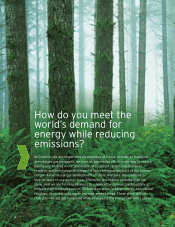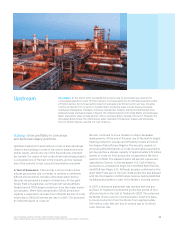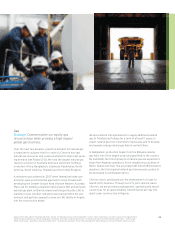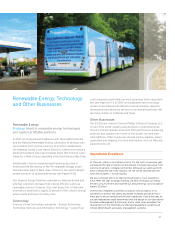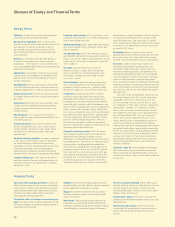Chevron 2007 Annual Report Download - page 25
Download and view the complete annual report
Please find page 25 of the 2007 Chevron annual report below. You can navigate through the pages in the report by either clicking on the pages listed below, or by using the keyword search tool below to find specific information within the annual report.
23
Strategy: Grow profitably in core areas
and build new legacy positions.
Upstream explores for and produces crude oil and natural gas.
Chevron has holdings in some of the world’s largest and most
prolific basins, and we are one of the top producers wherever
we operate. Our queue of new crude oil and natural gas projects
is considered one of the best in the industry, and we manage
one of the industry’s most successful exploration programs.
A Year of Successes: Chevron has a strong crude oil and
natural gas position and is a leader in working in extremely
difficult environments, including ultra-deep water. During
the year, we achieved a number of milestones. At the giant
Tengiz Field in Kazakhstan, our 50 percent-owned affiliate
Tengizchevroil (TCO) began production from two major expan-
sion projects. When fully operational in 2008, production
capacity is expected to increase from 300,000 barrels of crude
oil per day to 540,000 barrels per day. In 2007, TCO produced
its 1 billionth barrel of crude oil.
At a Glance At the end of 2007, worldwide net proved crude oil and natural gas reserves for
consolidated operations were 7.9 billion barrels of oil-equivalent and for affiliated operations were
2.9 billion barrels. Net oil-equivalent production averaged 2.62 million barrels per day, including
volumes produced from oil sands in Canada. Major producing areas include Angola, Australia,
Azerbaijan, Bangladesh, Denmark, Indonesia, Kazakhstan, Nigeria, the Partitioned Neutral Zone
between Kuwait and Saudi Arabia, Thailand, the United Kingdom, the United States and Venezuela.
Major exploration areas include western Africa, Australia, Brazil, Canada, the Gulf of Thailand, the
Norwegian Barents Sea, the international waters between Trinidad and Tobago and Venezuela,
the U.K. Atlantic Margin, and the U.S. Gulf of Mexico.
Left: El Segundo, California, refinery: Edward Shelton, design engineer.
Above: Tengizchevroil Sour Gas Injection/Second Generation Plant expansion projects, Kazakhstan.
We also continued to move forward on major deepwater
developments. At the end of the year, one of the world’s largest
floating production, storage and offloading vessels arrived at
the Agbami Field offshore Nigeria. The vessel is capable of
processing 250,000 barrels of crude oil and natural gas liquids
per day and has a storage capacity of approximately 2.15 million
barrels of crude oil. First production is expected by the third
quarter of 2008. The Agbami Field is 68 percent-owned and
operated by Chevron. In the deepwater U.S. Gulf of Mexico,
production is scheduled to begin from the Blind Faith Field by
mid-2008 (see Pages 6–7). Although progress continued on the
giant Tahiti Field, also in the Gulf, initial production was delayed
until the third quarter of 2009 when rigorous testing identified
metallurgical problems in part of the facility’s mooring system.
In 2007, a milestone agreement was reached with the gov-
ernment of Thailand to extend the production period of four
offshore blocks in the Gulf of Thailand to 2022. The extension
facilitates Chevron and co-concessionaires’ long-term plans
to boost production from the blocks from approximately
740 million cubic feet per day of natural gas to 1.2 billion
cubic feet per day.
Upstream







